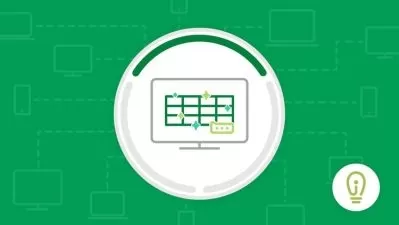Mastering Excel - Excel from Beginner to Advanced
Janah Reda
5:25:31
Description
The complete Excel course compatible with MS Office 365, or any version of Excel
What You'll Learn?
- Master Microsoft Excel from Beginner to Advanced
- Master unique tips & techniques that you won't find in ANY other course, guaranteed
- Basic data entry and manipulation
- Data analysis
Who is this for?
More details
DescriptionStudents: Excel is commonly used in many fields of study, including science, finance, and business, and having a strong understanding of the program can help students succeed in their coursework.
Professionals: Excel is a powerful tool for data analysis and management, and professionals in fields such as accounting, finance, marketing, and project management can benefit from a deep understanding of the program.
Entrepreneurs: Excel can help entrepreneurs manage their finances and track their business growth, as well as create marketing plans and analyze customer data.
Job seekers: Many jobs require knowledge of Excel, so taking an Excel course can make job seekers more competitive in the job market.
Anyone looking to improve their productivity: Excel can be used to streamline many different tasks, from creating lists and charts to managing schedules and budgets.
You can learn how to enter and format data in Excel, including how to add, delete, and modify cells and rows, format numbers and text, and use Excel's built-in functions to manipulate data.
Excel provides a wide range of data analysis tools, including pivot tables, data sorting and filtering, and various statistical functions. You can use these tools to explore and understand large data sets and to identify trends, patterns, and outliers.
Excel is widely used for financial modeling, including creating and analyzing financial statements, forecasting revenue and expenses, and conducting sensitivity analysis. By learning how to use Excel for financial modeling, you can develop a range of valuable skills that are highly sought after by employers.
Excel also includes a variety of tools for creating graphs and charts to help you visualize your data. You can learn how to create different types of graphs and charts, including bar graphs, line charts, pie charts, and more.
Overall, an Excel course is for anyone who wants to improve their knowledge and skills with the program, regardless of their background or profession.
Who this course is for:
- Basic data entry and manipulation: You can learn how to enter and format data in Excel, including how to add, delete, and modify cells and rows, format numbers and text, and use Excel's built-in functions to manipulate data. Data analysis: Excel provides a wide range of data analysis tools, including pivot tables, data sorting and filtering, and various statistical functions. You can use these tools to explore and understand large data sets and to identify trends, patterns, and outliers. Financial modeling: Excel is widely used for financial modeling, including creating and analyzing financial statements, forecasting revenue and expenses, and conducting sensitivity analysis. By learning how to use Excel for financial modeling, you can develop a range of valuable skills that are highly sought after by employers. Graphs and charts: Excel also includes a variety of tools for creating graphs and charts to help you visualize your data. You can learn how to create different types of graphs and charts, including bar graphs, line charts, pie charts, and more. Automation: Finally, Excel includes a range of automation tools, including macros and scripting, that can help you automate repetitive tasks and streamline your workflow. By learning how to use these tools, you can increase your efficiency and productivity, and make your work with Excel more enjoyable and rewarding.
Students: Excel is commonly used in many fields of study, including science, finance, and business, and having a strong understanding of the program can help students succeed in their coursework.
Professionals: Excel is a powerful tool for data analysis and management, and professionals in fields such as accounting, finance, marketing, and project management can benefit from a deep understanding of the program.
Entrepreneurs: Excel can help entrepreneurs manage their finances and track their business growth, as well as create marketing plans and analyze customer data.
Job seekers: Many jobs require knowledge of Excel, so taking an Excel course can make job seekers more competitive in the job market.
Anyone looking to improve their productivity: Excel can be used to streamline many different tasks, from creating lists and charts to managing schedules and budgets.
You can learn how to enter and format data in Excel, including how to add, delete, and modify cells and rows, format numbers and text, and use Excel's built-in functions to manipulate data.
Excel provides a wide range of data analysis tools, including pivot tables, data sorting and filtering, and various statistical functions. You can use these tools to explore and understand large data sets and to identify trends, patterns, and outliers.
Excel is widely used for financial modeling, including creating and analyzing financial statements, forecasting revenue and expenses, and conducting sensitivity analysis. By learning how to use Excel for financial modeling, you can develop a range of valuable skills that are highly sought after by employers.
Excel also includes a variety of tools for creating graphs and charts to help you visualize your data. You can learn how to create different types of graphs and charts, including bar graphs, line charts, pie charts, and more.
Overall, an Excel course is for anyone who wants to improve their knowledge and skills with the program, regardless of their background or profession.
Who this course is for:
- Basic data entry and manipulation: You can learn how to enter and format data in Excel, including how to add, delete, and modify cells and rows, format numbers and text, and use Excel's built-in functions to manipulate data. Data analysis: Excel provides a wide range of data analysis tools, including pivot tables, data sorting and filtering, and various statistical functions. You can use these tools to explore and understand large data sets and to identify trends, patterns, and outliers. Financial modeling: Excel is widely used for financial modeling, including creating and analyzing financial statements, forecasting revenue and expenses, and conducting sensitivity analysis. By learning how to use Excel for financial modeling, you can develop a range of valuable skills that are highly sought after by employers. Graphs and charts: Excel also includes a variety of tools for creating graphs and charts to help you visualize your data. You can learn how to create different types of graphs and charts, including bar graphs, line charts, pie charts, and more. Automation: Finally, Excel includes a range of automation tools, including macros and scripting, that can help you automate repetitive tasks and streamline your workflow. By learning how to use these tools, you can increase your efficiency and productivity, and make your work with Excel more enjoyable and rewarding.
User Reviews
Rating
Janah Reda
Instructor's Courses
Udemy
View courses Udemy- language english
- Training sessions 22
- duration 5:25:31
- Release Date 2023/04/11











